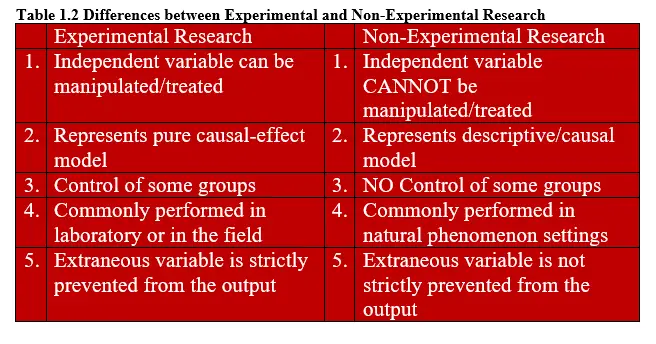Experimental Research-definition, methodology ,methods , characteristics, advantages and examples
1.1 Definition
Experimental research is a sub-set of Quantitative research and involves a systematic or step by step investigation on how to practically solve a research problem. As the name suggests, in all the processes of investigating the subject matter, there is element of experimenting. This term “experimenting” means there are alterations/manipulations or treatment done on a variable. So, in this case of experimental, it means that variables in the study are tempered with by the researcher (i.e., experimental). Therefore, in this criterion, the researcher/investigator advocates those variables should be observed under treatment condition.
Types of experimental research
The Quantitative experimental research under this criterion is three, namely;
- Pre-Experimental Research
- Quasi-Experimental Research
- True Experimental Research
1.1 Pre-Experimental Research
Definition- Pre-experimental designs are research schemes in which a subject or a group is observed after a treatment has been applied, in order to test whether the treatment has the potential to cause change.
Pre-experimental research is a sub-category of quantitative research which primarily is conducted to establish whether a treatment on an independent variable or group has the potential of causing significant change on the dependent variable. As the name suggests, it is a pre-mock or a preliminary test. Pre-experimental research is further classified in to three categories, namely;
One shot case study
One-group pretest–posttest Research
Static-Group Comparison Research
1.1.1 One Shot Case Study
One shot case study is a case of experimental research which entails one group. The researcher considers a single group which is subjected to treatment or a specific condition. Then, the group under treatment is post-tested. This is the only one group used and no other.
Example 1
Suppose a researcher wants to test if night prep program is introduced in the school can cause improved academic performance of grade nine pupils where by it is empirically evidenced by pupils passing well in their examination. The researcher randomly selects a class of 30 pupils in a certain school in Minnesota, USA. If he straight away subjects them to night preps program and tests their performance. If the results after examination is ministered is higher than in the case of normal reading of the students during the day, then it is concluded that night prep program is effective in helping pupils to perform better. Diagrammatically, this is presented below as per Figure 1.1
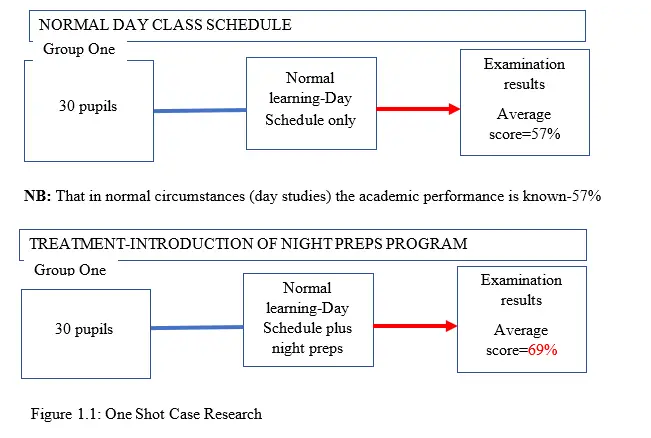
NOTE: One of the main challenges one shot case study has, is that the research findings are inconclusive. This is because the difference gotten after treatment may not necessary be due to the treatment or condition introduced such as night preps program as it is in the case above. This is because other extraneous variables may have contributed to such a change. Such as children born bright or children could have had under the “tree group discussions” during the day or during weekend.
1.1.2 One-Group Pretest–Posttest Research
One-Group pretest-posttest research is a case of experimental research which entails one group. The researcher considers a single group which is subjected to the first test (pretest) first of all to establish the current status quo of the group before treatment. Then the researcher goes ahead and subject the same group to a certain treatment or condition whereby after that treatment, another test (posttest) is performed to assess the change which have occurred on the dependent variable. This is an improved version of the one-shot case study, only that the same group is tested twice.
Example 2 (i.e., expansion of previous example 1)
Suppose a researcher wants to test if night prep program is introduced in the school can cause improved academic performance of grade nine pupils where by it is empirically evidenced by pupils passing well in their examination. The researcher randomly selects a class of 30 pupils in a certain school in Minnesota, USA. He first of all tested (i.e., pretest) their academic performance in normal circumstances and further retested (i.e., posttest) them after subjecting them to night preps program. If the results after examination is ministered is higher than the results gotten after the first test (i.e., pretest), then it is concluded that night prep program is effective in helping pupils to perform better. Diagrammatically, this is presented below as per Figure 1.2
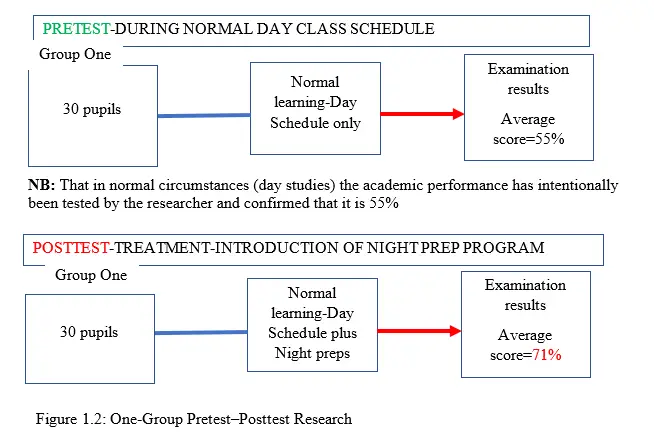
NOTE: The researcher is in a better position to compare the scores from the two test to make conclusive decision. Although one group pretest-posttest research design is far much better than the one-shot case research, it still has its challenges because you still realize that the researcher is not 100% sure that the changes observed on the dependent variable is purely from the independent variable. This is because some extraneous variables may have paved way to explain the changes noted down. This calls for the next improved pre-experimental research, namely; static-group comparison design or research.
1.1.3 Static-Group Comparison Research
Static-group comparison research is a case of experimental research which entails two groups. First group is the comparison group while group two is the experimental group both chosen without using any random method. Hence referred to as static groups. The researcher then does not do anything (i.e., no treatment) to the comparison group which acts as the default or original group. On the other hand, group two (i.e., treatment/experimental) is subjected to treatment or the condition of interest. After that, the two groups are post tested. The aim of having a comparison group is to compare the results thereof to reveal what the results by the members of the experimental group would have been, had they not received the treatment.
Two things to remember under static-group comparison research;
-No pretest is subjected to the two groups before treatment as it is in the case of one-shot case research.
-For this experiment to work, the two groups must be equivalent.
Example 3 (i.e., expansion of previous example 1)
Suppose a researcher wants to test if night prep program is introduced in the school can cause improved academic performance of grade nine pupils where by it is empirically evidenced by pupils passing well in their examination. The researcher randomly selects a class of 30 pupils in a certain school in Minnesota, USA. He brands the first group as the comparison group and the second one as the treatment group. He further subjects group two (treatment group) tonight prep program and does nothing to the comparison group. The researcher then tests the academic performance of the two groups-a posttest examination. If the results after examination is ministered is higher for the members of the experimental group as compared to the comparison group/class, then it is concluded that night prep program is effective in helping pupils to perform better. Diagrammatically, this is presented below as per Figure 1.3
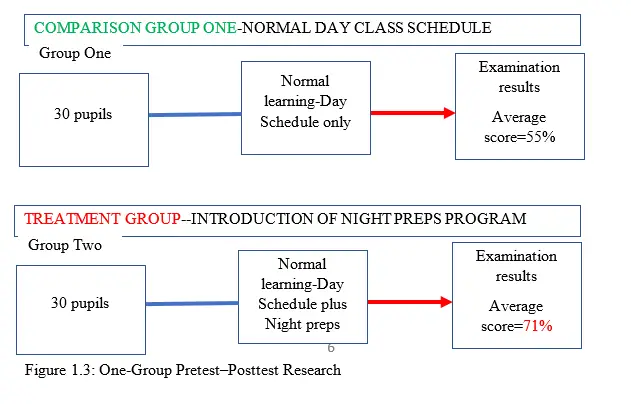
NOTE: One-Group Pretest–Posttest research is really an improved pre-experiment research but still it lacks external validity for the condition of making the two groups to be equivalent is hard for both of them may perform better for the researcher cannot control external factors such as weekend private tuition where by the pupils may under-go and add their performance ability.
2.1 Quasi-Experimental Research
Quasi-Experimental research is an experimental study where by the researcher endeavors to establish the cause-effect of the manipulated independent variable on the dependent variable without random assignment. This type of research lacks the randomization element on both the control and the treatment groups. It is said to be a quasi-experiment referring to false experiment for although it is similar to true experimental research, it lacks random assignment which potentially results in groups that are non-equivalent. For example, in a case where by the researcher chooses one whole group from a population and classifies it as the treatment group and at the same time use a proportion of the same group as a control group or the second group may be from a different population but with the same characteristics. Such that the treatment group has more advantage as compared to the other one due to selection biasness.
Quasi-experiment research is classified in to;
- Matching posttest- only control group research
- Matching pretest–posttest control group research
- Counterbalanced research
- Time-series research
2.1.1 Matching Posttest- Only Control Group Research
This is the FIRST category of quasi-experimental research whereby the researcher uses two groups from the same population and since it is not possible to make them be equivalent to each other due to the fact that they are already naturally dividend on the line of certain criteria for instance such as sex, the researcher tries to use one or more variables other than the natural one to make them equivalent. The group labeled as treatment group is subjected to treatment and the control group on the other hand is not treated. i.e., nothing is done to that group. Then both groups are exposed to posttest where by the scores are used to compare the changes occurring on the dependent variables.
Illustration 1
Researcher (1) wanted to test the effectiveness of anti-obesity tablet manufactured in Germany. He un-randomly (i.e., said to be quasi) selected 20 male and 20 female patients from a certain hospital. The 20 males were categorized as the treatment group and the 20 females were treated as the control group. The researcher tried to make the two groups equivalent by the fact that they were equal in numeric terms (i.e., 20 each group) and again from the same population or hospital environment.
NB: Before we go far, note that naturally the two groups are divided by the fact of sex-male vs female (i.e., are unequal). The researcher looks for other variables to make them equivalent of each other-i.e., picking a total of 20 from each group and from the same population.
The researcher administered the male group with the anti-obesity tablets for two weeks while the female group which was the control group received nothing. After the two weeks, both groups (treatment and control groups) were tested for obesity cells in their body. The research findings portrayed that the majority of male patients had less concentration of obesity cells in their body as compared to female patients who majority of them had high concentration of obesity cells. It was concluded that the tablets were effective. This is demonstrated by Figure 1.4 below
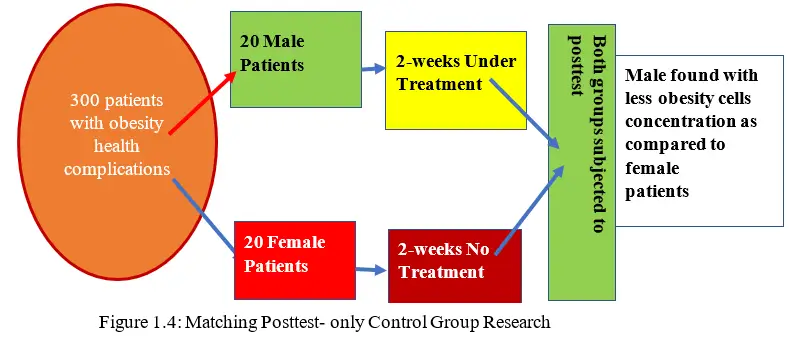
One of the major drawbacks of Quasi-experimental research is that internal validity is always questionable for the treatment and the control groups are never comparable no matter how much efforts the researchers try to make them equivalent. Some of the causes of these pitfalls are commonly referred to as threats to Internal Validity. They include;
Self-Selection Effects Threats-that is the independent variable occurs before the researcher comes in and the independent variable is self-chosen by the participants. For example, when the researcher finds that the respondents are already cigarette smokers even before the researcher starts to study the effect of smoking. Here, smoking habit is the independent variable whose effect is to be studied and you see, it has already occurred for the smoker has been smoking anyway.
Experimental Mortality Threats- the researcher cannot conclusively explain the cause effect element associated with those participants who dropped from the study and it may not be okay to quickly assume that they had the same information to those who completed the study. A good example is the case of some unanswered questions in SPSS program where by some respondents did not duly fill the questionnaire. The conclusions will be made from the information of those who duly filled the questionnaire but the researcher cannot quickly conclude that those respondents who partly filled the questionnaire had similar information. This is experimental mortality threat.
History Threats-this is a case where there occurred an abnormal event in the past that could have trickled down to the behavior being identified in the current study participants which may not be part of the experiment itself. This implies that the study may not capture true information in the normal environment. This causes data invalidity problems. For instance, when I was young, my parents exposed me to agricultural and pastoral activities under very harsh conditions which made me hate pastoralism and agricultural activities. In fact, up to date I have a very bad stigma on cattle keeping and agricultural affiliated activities. Today, I prefer being glued on my laptop doing research and other online activities rather than doing farming or keeping cattle. This is an historical threat for if a researcher wishes to study the level of popularity of cattle keeping or agricultural matters in my society, then issues me with a questionnaire, then the information I will provide will be misleading for historically I have a negative view.
Maturation Effects Threats- this is a case where by the observed characteristic of interest may fade away with or without any treatment. For instance, in a case of peer pressure, a participant may portray negative attitude towards a certain matter which is totally disliked by his/her peers. But with time; the behavior fades away or remains a little bit based on the maturity level of that respondent. A good example is stress level amongst the youth. For example, due to dependency level being high amongst the youth due to lack of income, this will fade away as you complete their training courses and secure jobs. Another example is decline of depression amongst the old aged people. They may be worried of the future of their children hence they live under high depression levels. But as they become more and more older, they lose memory hence depression goes down.
Regression toward the Mean Effects Threats-this is a tendency of an individual to perform lesser and lesser towards the common mean or average especially when in the initial test the individual had highly performed. Equally, it refers to a case where by an individual who had lowly performed performs better in the future. A good example is school children in lower grades, as they join higher grade or level those who had highly performed starts to go down.
Testing Threats. This is a case where by the test being undertaken itself can interrupt the expected outcome. This is common especially in hospital where test of pretest nature is administered on the participant. The first test may be affected by the psychological state of the patient. For example, if one is being tested of cancer or HIV Aids, the blood pressure may be high for there are worries that the disease is incurable. Another example is like in the case of the first continuous assessment tests in class for the beginners is always lowly performed due to lack of familiarity with the format. The proceeding ones are usually different.
Instrument Decay Threats-this is a case where the pretest gives more reliable and valid results if the machine being used to test has new batteries for instance or it is a brand-new gadget. However, for the posttest case, the results may be faulty for if the batteries have gone down or the machine for the test is ageing, then the readings cannot be correct. Hence wrong findings.
2.1.2. Matching Pretest–Posttest Control Group Research
This is the SECOND category of Quasi-experimental research where by the pretest scores serve as the basis for matching participants across the groups so as to create equivalence amongst them something that was hard in the case of Matching posttest- only control group research. Therefore, this is a slightly improved design. In this research, the investigator administers a pretest to all participants with the aim of making them equal. So, how is this achieved? He or she uses the test results gotten and then pairs/matches the participants based on the marks scored. For example, those with 45 are matched with those with 45 scores or thereabout to form one group. Those with 56 scores or there about are put together and so on and so on. Out of this exercise, further categorical groups are then formed by putting each participant from the pairs into either experimental group and others into the control group. The result is two groups that are relatively similar on the variable of interest, as measured by the pretest. From that point, the researcher subjects the experiment group with the treatment while controlling the other one. A posttest is carried thereafter to compare the results for the two groups as portrayed in illustration 2.
Illustration 2
Researcher (2) wanted to test the effectiveness of anti-obesity tablet manufactured in Germany. He un-randomly (i.e., referred to as quasi) selected 40 male and female patients from a certain hospital. The 40 patients were first subjected to pretest to establish their level of obesity cells concentration in their bodies. The researcher tried to make the two groups equivalent by pairing them based on their level of obesity cell concentration in their body. After that, the groups which were formed were based on the pretest scores and were further re-distributed to treatment group and the control group. Then the treatment group was subjected to anti-obesity tablets for two weeks, while the control group was not. Then both groups (treatment and control groups) were tested for obesity cells in their body (i.e., posttest). The research findings portrayed that the majority of treatment group had less concentration of obesity cells in their body as compared to control group members who majority had high concentration of obesity cells. It was concluded that the tablets were effective. This is demonstrated by Figure 1.5 below
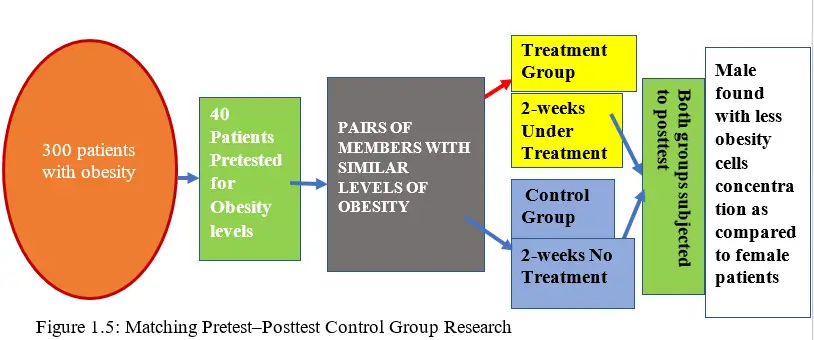
2.1.3 Counterbalanced Research
Counter balanced design is the THIRD category of Quasi-experimental research where by all the groups are exposed to each treatment. Such that if there are three tests, there will be three groups and all the three groups will have to be tested although the order may vary the selection of the group to be tested at any point in time. The selection of the groups is done at random. The possible groups to be formed is aided by Factorial approach which is common in the discipline of Mathematics. The formula is as follows; n! =n(n-1)
Where:
n – the total number of elements in a set or number of groups to be tested.
Illustration 3
Researcher (3) wanted to test the extent to which a subject matter would respond to certain two treatments/conditions. The subject matter was divided in to two groups, X and Y. Therefore, each group was to be tested against the two conditions or treatment as follows as per Figure 1.6;
Workings; Note that if there are two treatments, then the groups to be treated are derived at as follows; n!=2!=2X1= Two groups for two treatments. Therefore,

Illustration 4
Suppose the researcher in illustration 3 above considers three treatments, then the subject matter will be divided in to six groups. That is if he/she wanted to test subject matters influence by certain three treatment/conditions. The subject matter will be divided in to six groups (i.e., 3X2X1), X,Y,Z, U,V and W. Therefore, each group has to be tested against the three conditions or treatment as follows as per Figure 1.7;
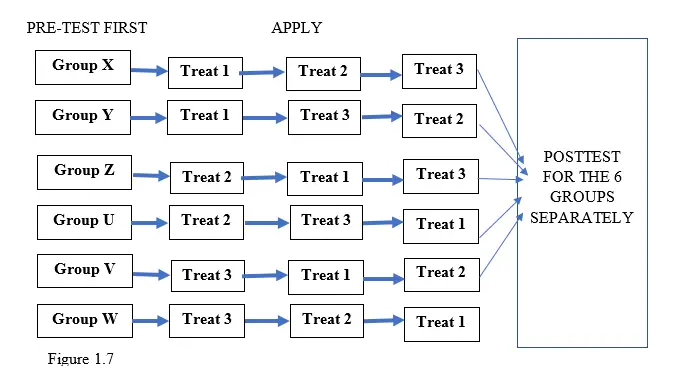
This research approach is a design used by many researchers especially when they want to equalize groups. In general, the number of treatments is always equal to the number of groups to be tested.
2.1.4 Time Series Research
This is the FOURTH category of Quasi-Experimental research design which is of the one-group pretest-posttest nature. It entails pretesting the participants on a continuous or repetitive manner so as to determine the most stable results before the subject matter is subjected to treatment. Once results are promising, then the treatment is introduced and immediately a posttest is undertaken to determine the effect of the treatment. It should be noted that, just like in the case of pretest the posttest is done in a repetitive manner to arrive at stable outcome. If the results are significant, then it is concluded that the treatment imposed was effective.
Illustration 5
Researcher (4) wanted to test the extent to which a subject matter would respond to certain single treatment/condition. The subject matter was subjected to pretest for 3 times and the 4th test gave stable outcome. Then the subject matter was imposed into a certain condition/treatment and further posttests were carried out. Therefore, each group has to be tested against the condition or treatment as follows as per Figure 1.8;

3.1 True Experimental Research
True Experimental research is a type of research of quantitative nature which is said to be rigorous in terms of the number of independent variables that are normally manipulated to predict the outcome of the dependent variable. It is gold standard research for it takes care of both the internal validity (i.e., causality) for it focuses on cause-effect relationship between and amongst variables which is achieved by the researcher performing manipulations on the independent variables to see the changes thereof and external validity for the researcher uses control groups to eliminate spurious or/nonsense correlations brought about by extraneous variables.
This research is also termed as a superior one as compared to the rest for it uses both random selection and random assignment. Whereby, under random selection, the researcher randomly chooses the sample size from the whole population whereby all the population items are given equal chances of being picked for the experiment or study and it promotes external validity which is associated with generalizability. While for random assignment, it entails a procedure of randomly posting the research participants to either the control group or experimental group and it promotes internal validity. Random assignment is the standard procedure which is used by the researcher to make both experimental and control groups to be similar/or equivalent as it ought to be.
Applicability of True Experimental Research
True experimental research is commonly used in explanatory research where an in-depth explanation of the mechanism behind the cause of a certain kind of results is needed. It can further be conducted in a laboratory or in the field.
If true experimental research is undertaken from a laboratory, which is an artificial setup, the researcher is assured of internal validity but it is not possible to generalize the results (i.e., low external validity). Contrary, for the field experiment, the set-up is more real and hence both internal and external validity is promoted. True experimental Research is further classified into;
i). Posttest-only-Control Research
ii). Pretest-Posttest Control Group Research
iii). Solomon Four Group Research
3.1.1 Posttest-Only-Control Research
Posttest-only control group research is true experimental research which entails the process of randomly assigning participants of the research process to both the experimental and the control groups and carry out posttest only after manipulation has taken place so as to assess the effect of the intervention thereof. This implies that the common pretest that researchers normally undertake does not apply here. The following Figure 1.9 demonstrates how this research works
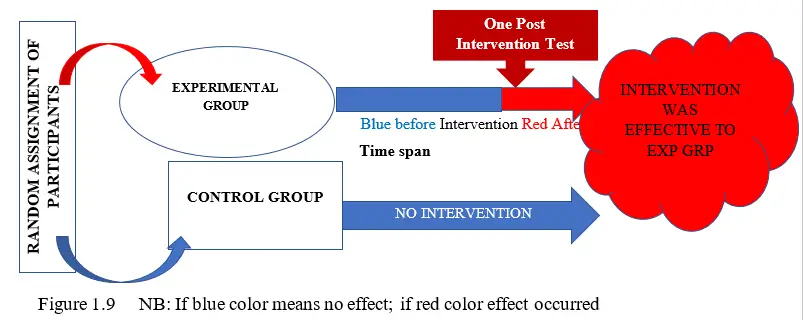
Advantages
1.Equivalence of groups under study
At the basics (i.e., at the beginning), both experimental and control groups are equivalent due to the randomization approach used to assign the elements of participants to the two groups. For the two groups has equal chances of being assigned participants.
2.Possible to control extraneous factors
External factors that influence outcome of the study can be controlled using the comparison group. Such factors may corrupt the research findings for they happen at the same time as the intervention and can influence the outcome so there is need of keeping them at bay. The advantage of this research is that it avoids the extraneous variable becoming a competing hypothesis and a probable basis of biasness.
3.Suitable in concealing the participant’s secrets
The research type is a good one especially when there are measurements to be taken from the participant before and after the treatment for the information is recorded in secret for future identification and matching to arrive at the correct findings.
4.No pretest biasness in the final research findings
For the researches with pretests, the outcome can influence what is expected in the posttest results. But this is not the case here. For instance, if a patient had been tested of Covid-19 and found to be positive, after intervention of ministering the Covid-19 vaccine, further posttest will be affected by the earlier results of pretest for, they were positive. So, the researcher will even be tempted to give the same positive results even when the client or patient has already recovered.
5.Suitable where pretest does not apply
This type of research is applicable in cases where the pretest is not applicable due to either cost, time or location implications which may inconvenience the researcher. The researcher is at an advantage for as long as it is possible to introduce intervention and do posttest, then it is well.
Disadvantages
1.Loss of equivalence between groups
Due to attrition, both control and experimental groups may lose equivalence when participants quit the study due to reasons best known by them. This scenario is common especially when the intervention process is a long one or time-consuming which force some of the participants to quit.
2.No clear-cutting line on the intervention effects on the sub-groups
The challenge on the posttest-only research is that it is not possible to tell which subgroup of participants responded more to the intervention or manipulation for the researcher could not establish the initial position of each group for pretesting was missing in the first place.
3.Only applicable where a large sample size exists
This study does not apply to small population or where the sample size is small. This is because if the sample is a small one in size, then the process of randomly assigning participants in the set groups will not be possible.
4.Research findings are not generalizable
This type of research is characterized by low external validity for there are dissimilarities between the research participants and the population the researcher intent to use to generalize. That is the sample used in the research exercise is not a true representation of the population. So, it is not very easy or practical to generalize the research findings.
3.1.2 Pretest-Posttest Control Group Research
Pretest-Posttest Control Group research is a randomized experimental type of research which entails assignment of the participants into the experiment/treatment group and the control or comparison group using random approach of allocation. This is then followed by a pretest for both groups before intervention/treatment is performed on the experimental group only. Then the last step entails post testing of both experimental and control groups to establish the research findings. The following Figure 2.0 demonstrates how this research works.
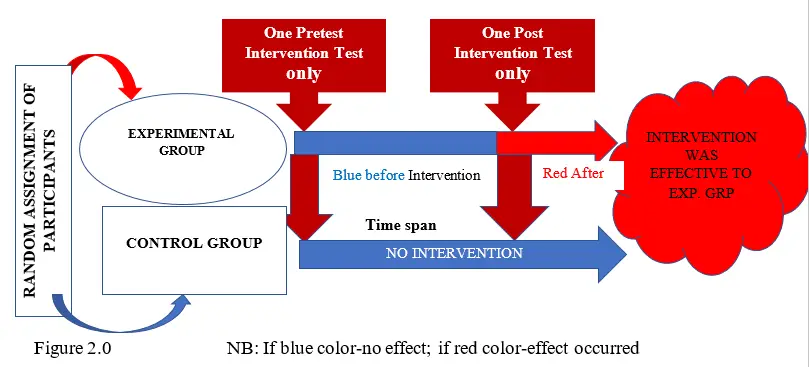
Advantages
1.No internal validity threats
Internal validity is assured which establishes the cause-effect implications. This objective of the researcher is achievable because the research uses the randomized assignment of the participants. This advantage increases the power of the research design to sense an influence caused by the predictor variable.
2.Intervening effect is clear in any relationship between two variables
This type of true experimental research help in creating distinction between the cause-effect association caused by the independent variable and the extraneous variables or factors. So, when this is the case, then no confusion on the side of the researcher in determining the variable which are responsible for the changes seen in the dependent variable.
3.Possible to establish the status quo of the both groups
The pretest done in the beginning of the research process before any manipulation is done enables the researcher to understand the status of the groups so as to notice any extraneous influence from other factors other than the predictor variable.
4.Elimination of attritions problem
The pretest-posttest control group research helps in eliminating participant fallouts which may cause imbalances between groups. That is, participant’s availability is assured throughout the research exercise.
5.Elimination of selection biasness
Pretest-posttest control group research aid in ensuring that validity of research findings is maintained for the randomization of assigning of participants in the two groups helps eliminate subjectiveness to the will of the researcher. Hence the results thereof are reliable.
Disadvantages
1.Low chances of truly representing the population
Participants of this type of research may not necessarily portray the characteristics of the entire population for not everybody involved in the research is eligible to be subjected to the intervention. For instance, those in the control group are not given any treatment yet they are part of the population.
2.Hard to generalize the research findings
This study does not create room for generalizing the results for the participants may not fully represent the whole population.
3.Risk of interference by extraneous factors
This type of research is superior as compared to others but still there are threats of influences from other factors not accounted for in the cause-effect model. This may adversely influence the research outcome.
3.1.3 Solomon Four Group Research (by Richard Solomon, 1949)
As the name suggests, the Solomon four group research is a type of study which advocates use of four groups which originate from the previously discussed two categories of true experimental research of POSTTEST-ONLY GROUP research and PRETEST-POSTTEST GROUP research. This study which was established by Solomon advocates that randomized assignment of participants to the four groups. Then, the researcher pretests two groups first. The next two groups receive no pretest at all. And at last, posttest is performed to all the groups whether experimental or control groups. This procedure is as demonstrated in Figure 2.1 below;
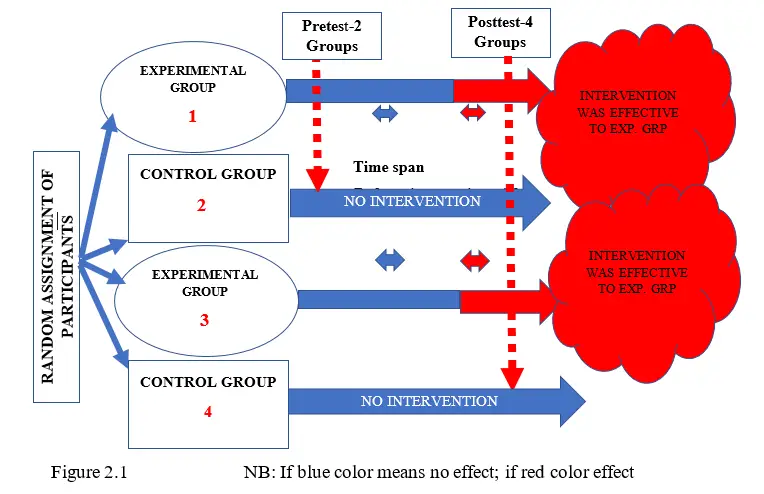
Advantages
1.Avoids internal validity threats
This research designs eliminates internal validity for two groups in this design are a replica of pretest-posttest nature and this gives the Solomon four group design the ability to guard the causal-effect implications from being interfered with. This is because the use of randomized assignment of participants to groups is a key step in ensuring that internal validity is maintained. Such that if the manipulations are undertaken, the changes gotten in the dependent variable are directly related to the independent variable.
2.Avoids external Validity threats
Solomon Four Group research helps in preventing external validity threats such as pretest sensitization. This is because the use of randomized selection of participants from the population is a key step in ensuring that external validity is maintained.
3.It is hypothetical
This research design is characterized by a specific hypothesis which govern the research problem. Such that the researcher relies on the independent variable which is subject to manipulation and at the same time there exists a dependent variable which is measured against the independent variable to assess the effects thereof.
Disadvantages
1.Costly to the researcher
This research design is more expensive to the researcher as compared to the other two true experimental research types, namely; posttest-only-Control Research and pretest-posttest control group research. Yet they almost give the same results.
2.Requires large sample size
Solomon Four Group research as the name suggests, requires a large sample size or almost the whole population so as to cater for the four groups which require substantial number of participants. Therefore, this type of research may not be suitable in the case of small population.
3.Duplication of efforts
There is no material difference between Solomon four group and pretest-posttest group research for one is a subset of the other. That is pretest-posttest group research is also accommodated in Solomon four group research. This is duplication of efforts and wastes the time and resources.
Experimental research methodology
Does experimental research methodology for formulating a research problem the same as experimental research method for data analysis? The answer is NO. Look at the definitional differences as per our explanation below.
4.1 Definition
Experimental research methodology is the reasonable headway or step by step design on how to solve a research problem through gathering of the relevant information. Experimental research methodology entails selection of logical procedure on the topic to be studied. That is the research problem, how specific objectives will be identified/or expressed. Identification of research gaps to be filled, research hypotheses to construct, the methods utilized to identify population and sample size, nature of data to be collected and how it will be analyzed, data presentation and interpretations thereof and the reporting of the research findings.
The aforementioned description on experimental research, whether of pre-experimental,
quasi-experimental or true experimental nature, this research methodology is in tandem with Kothari (1984) suggestion who was of the idea that research methodology is the underpinning behind the methods we use in the context of our research study. This provides a logic as to why one is using a particular method or technique at a particular stage in the research process and not others so that research output is accomplished as expected.
4.2 Questions experimental research Methodology tries to Answer
The experimental research question focuses on influence of the predictor variable on the dependent variable where by the predictor variable is manipulated. In other words, it is modified. For example, “Does cigarette smoking cause cancer amongst the youth?” This is an example of experimental research question in which the researcher is primarily interested in causal connection. Other experimental research questions may include and not limited to;
“How does the size of the vehicle wheels affect the speed the vehicle moves at?”
“What makes performance rate in schools improve?”
All these are examples of experimental research questions in which the researcher is primarily concerned with difference between two groups, seeking to establish a cause-effect association. So, this study tries to answer “What” and “How” kind of questions.
The following matrix depicts the link between experimental research and the type of research methodology adopted and then a clarification of the rational approach linked with this type and then in the last column, the research method(s) used in formulating the research problem. Remember these methods are specifically for experimental research which is a sub-set of Quantitative research as shown in Table 1.1

4.3 Experimental Research Methodology-Diagrammatic Approach
The following diagram represents a summary of logical roadmap to be adhered to in experimental research methodology where quantitative or numerical methods are used to measure/gauge the study variables as depicted in Figure 2.2
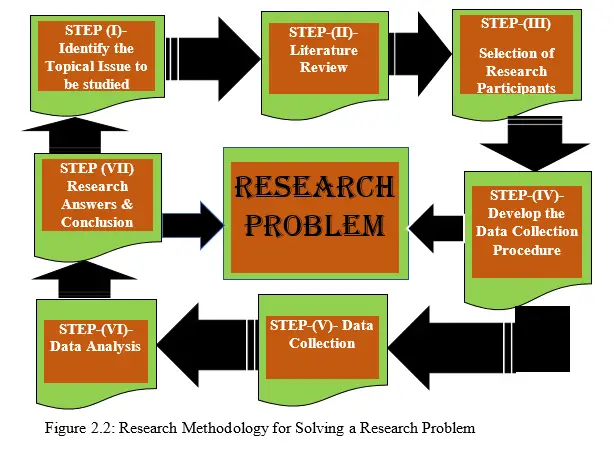
4.4 Logical Steps; Experimental Research Methodology
The following logical steps describe the experimental research methodology. From step one to seven, it represents a logical way of how systematically the matter at hand need to be dealt with. Remember that in this approach, the researcher only carries observations on the characteristic of the variable or the phenomenon being studied and can manipulate the variable or phenomenal state.
Step (I)- Identify the Topical Issue to be studied
In this step, the researcher arrives at the topical issues to be studied if he or she first of all succeeds in identifying the type of manipulation or treatment to subject to the independent variable. Then secondly, he or she has to identify a methodology of measuring the dependent variable to establish the effect it experiences from the manipulated independent variable. So, where it is logically or practically possible to identify a cause-and-effect association between or amongst variables, then this is a good case to build on.
Step-(II)- Literature Review
The second step after identifying the area of study is literature review. In this case, the researcher needs to identify past studies with variables that can form cause and effect rationale or plausibility perspective. The review will also aid in identifying the controls needed for comparison purposes.
Step-(III)-Selection of Research Participants
Unlike other types of research, the experimental research identifies participants using both randomized assignment and randomized selection. The aim of randomized assignment is to create equivalence between the groups being used. For randomized assignment should be logical and if not the case, then other plausible approaches should be applied such as matching.
Step-(IV)- Develop the Data Collection Procedure
Step four entails establishment of the data collection design which is the collection of possible methods that is suitable to collect the required data. This can either be observational study, simulations and surveys.
Step-(V)- Data Collection
Data collection can be from any source as long as at the end of the day the data is expressed in quantitative format. In other words, the data can be qualitative but at the end the variables whose characteristics are being measured should be in form of quantitative perspective.
Step-(VI)- Data Analysis
Data analysis process in this type of research is unique for it depends on the nature of the sub-classes that form the experimental research. However, in a nutshell, the analysis entails both descriptive and inferential analysis where comparison of two or more variables is undertaken to establish the cause-and-effect linkages.
Step (VII) Research Answers & Conclusion
The last step 7 entails researcher providing answers to the research questions raised from the word go. In this stage, the researcher needs to state whether the variables under consideration are plausibly related through cause-effect connections or otherwise.
Experimental research data collection methods
Research methods are all the procedures that are utilized in all the stages of research courses. They are apparatuses used to ensure the end results of research task are accomplished. These techniques vary from one stage of research process to another. These methods are further classified into two categories, namely;
a) Pre-Data analysis methods
b) Data Analysis related methods
As per Table 1.1 in this article, the experimental research methods indicated in that table (refer), namely; Randomized experiments, or quasi-experimental designs, are for the purposes of formulating the research problem and are some of the methods which fall under pre-data analysis category. However, in this discussion of experimental research, we will focus first on the THREE main methods of data collection which are also pre-data analysis in nature. That is; observational study, simulations and surveys.
Observational Data Collection Method
It is an approach of collecting data in a more direct manner whereby the researcher physically watches a behavior being portrayed. This is a common approach in behavioral science. The researcher observes things as they happen live without directly asking the respondent to give an opinion.
Simulation Data Collection Method
It is a method of data collection which emanates from empirical studies. It involves establishment of empirical model which answers “what if questions”. The simulation model is built from the experiment undertaken where by new data is generated from the simulation model. The models used herein may assume mathematical, physical, or computer replicas which represent a real-life situation. Simulation data collection approach is applicable when either it is difficulty to access actual condition due to the costs implied thereof or the data collection procedure is threatening to the researcher or it is not practical. It is an approach common in the field of engineering and operational research.
Surveys
It is one of the most commonly used data collection approaches and it involves use of diverse methods such as survey data sheets, online or physical questionnaires and telephone calls.
Characteristics of experimental research
Experimental research being a superior type of research is also dominated by unique characteristics which include and not limited to;
- The dependent variable acts as the control group and the independent variable is the manipulated factor in the study model.
- Manipulation of the independent variable-the researcher treats the predictor variable to assess the effect thereof on the dependent variable.
- Study is carried outside its natural phenomenon conditions-the experiment is undertaken in a laboratory or in the field and the natural conditions that surround the study object in the normal circumstances are controlled.
- Observation process is continuous over time to be able to make conclusions that are reliable.
- Assignment of participants is on randomized manner – when participants are being allocated to either experimental group or comparison group, it is done in a scientific manner (randomly) so as to give each participant equal chances of being placed in a group (i.e., being equalized).
- Extraneous variables are under control- These variables adversely influence the end results of the study and one of the common practices of the researcher is to suppress such variables so as to determine the pure influence of the predictor variable on the dependent variable.
- Ethical considerations-in experimental research ethical issues are key and the researcher need to comply such that the details of the participants are not disclosed to anyone.
Advantages
1.Control of unwanted variables
Experimental research targets specifically some variables of interest. Therefore, the results gotten are rest assured to the researcher that they are perfect. In other words, cause and effect models are free from any interruptions of extraneous variables.
2.Flexibility in its application
Experimental research is wide spreading and applies in many fields. So, it can fit in all multidisciplinary faculties or industries. Hence it has a wide usage to many end users.
3.Conclusive research findings
Experimental research ends up producing unique results for the high controls put in place ensures that conclusions on the linkage between variables is sure. No confusion on which factors affect which ones for the researcher is sure.
4.It is possible to duplicate experimental results
Once results have been gotten, the outcome is straight forward and can be used by other scholars in similar models. For example, a variable that was controlled in a scenario one can be used in another similar study to play the same role. For example, the relationship between cost and output of a product cuts across and the formula Y= a +bX applies in all scenarios.
Where Y=Level of cost
X=Level of output
a=cost which is constant
b= rate of change in cost due to change in level of output
5.-Applies well in cause to effect modeling process
Since experimental research entails treating one group of participants and controlling the other group, this ends up with well-articulated results which fit in the cause-effect model.
As a result, the body of knowledge in increased.
6.Easily compactible with other research methods
This research being characterized by rigorousness in data analysis, it gives the study a better chance to fit in other many studies. This allows experimental research to be able to provide the scientific rigor that may be needed for the results to stand on their own. It provides the possibility of determining what may be best for a specific demographic structure or population of a certain character.
7.Applies well in explanatory research
It is suitable in addressing the explanatory research for it tries to provide an in-depth description of the key causes of a particular variable.
Disadvantages
1.Time consuming
Some of the sub-categories of experimental research are procedurally long and take a while before the researcher arrive at concrete conclusions. This is time consuming.
2.Not possible to generalize the research findings
The research is most of the times carried out in the laboratory or in the field where the environment is controlled. Such that the end results may not necessarily portray the population characteristics in its natural phenomenon.
3.Subjective to researcher’s mistakes
Since this is an experimental transaction, the researcher may error during manipulation and this will result to misleading research findings.
4.It is costly to the researcher
To undertake experimental research is resource consuming for there is, in most of the cases need for a laboratory which is very expensive to build or hire and also for the field study, in depth preparations are required which are finance consuming.
5.Non-Descriptive.
Experimental research only shows the cause-effect relationship between two or more variables. But it is not possible to describe the nature of the variable in its natural phenomenon.
Examples of experimental research
Experimental research is common in some fields such as Education, Medicine and Social Studies. Some of the examples used in this article are;
1.Entry behavior examination-when students are joining a certain course, for instance Education Psychology, the examiner may wish to assess what the students generally know about this field before imparting the knowledge.
2.Impact of capsules-in medicine, the researcher may wish to know whether a certain tablet is effective in curing of a certain disease or not.
3.Employee need assessment-the employer may wish to know the needs for training in a certain skill. Then a need assessment is necessary to find out the status quo and the end effects after the training.
Differences between experimental research and non-experimental research
In this article, the discussions thereof portray that quantitative research is broad and divided in to two categories, namely; experimental and non-experimental research. So, the question is, what are the distinguishing features of these two categories/ The following Table 1.2 portrays this differences.
